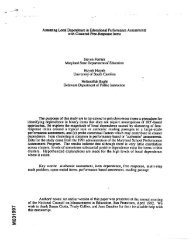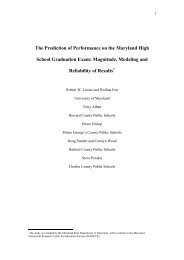A Brief Introduction to Evidence-Centered Design CSE Report 632 ...
A Brief Introduction to Evidence-Centered Design CSE Report 632 ...
A Brief Introduction to Evidence-Centered Design CSE Report 632 ...
You also want an ePaper? Increase the reach of your titles
YUMPU automatically turns print PDFs into web optimized ePapers that Google loves.
Mislevy, R.J., Steinberg, L.S., & Almond, R.A. (2002). <strong>Design</strong> and analysis in taskbasedlanguage assessment. Language Assessment, 19, 477-496. Also available as<strong>CSE</strong> Technical <strong>Report</strong> 579. Los Angeles: The National Center for Research onEvaluation, Standards, Student Testing (CRESST), Center for the Study ofEvaluation, UCLA. http://www.cse.ucla.edu/CRESST/<strong>Report</strong>s/TR579.pdf.[ECD perspective on designing task-based language assessments. Includesexamples of Bayes nets for tasks that tap multiple aspects or knowledge andskill.]Mislevy, R.J., Steinberg, L.S., Breyer, F.J., Almond, R.G., & Johnson, L. (1999). Acognitive task analysis, with implications for designing a simulation-basedassessment system. Computers and Human Behavior, 15, 335-374. Alsoavailable as <strong>CSE</strong> Technical <strong>Report</strong> 487. Los Angeles: The National Center forResearch on Evaluation, Standards, Student Testing (CRESST), Center for theStudy of Evaluation, UCLA.http://www.cse.ucla.edu/CRESST/<strong>Report</strong>s/TR487.pdf. [<strong>Design</strong> and conduct ofa cognitive task analysis of expertise in dental hygiene, from the perspective ofinforming the construction of the models in the ECD conceptual assessmentframework.]Mislevy, R.J., Steinberg, L.S., Breyer, F.J., Almond, R.G., & Johnson, L. (2002).Making sense of data from complex assessment. Applied Measurement inEducation, 15, 363-378. Also available as <strong>CSE</strong> Technical <strong>Report</strong> 538. Los Angeles:The National Center for Research on Evaluation, Standards, Student Testing(CRESST), Center for the Study of Evaluation, UCLA.http://www.cse.ucla.edu/CRESST/<strong>Report</strong>s/RML%20TR%20538.pdf[Argument that the way <strong>to</strong> design and analyze complex assessments, such ascomputer-based simulations, is from the perspective of the evidentiaryargument—not from the perspective of technology. Ideas are illustrated insome detail with the DISC pro<strong>to</strong>type assessment of problem-solving in dentalhygiene.]Steinberg, L.S., & Gi<strong>to</strong>mer, D.G. (1996). Intelligent tu<strong>to</strong>ring and assessment built onan understanding of a technical problem-solving task. Instructional Science, 24,223-258. [Concerns the interplay among cognitive analysis, instructionalstrategy, and assessment design, in the context of the HYDRIVE intelligenttu<strong>to</strong>ring system for troubleshooting aircraft hydraulics.]Steinberg, L.S., Mislevy, R.J., Almond, R.G., Baird, A.B., Cahallan, C., DiBello, L.V.,Senturk, D., Yan, D., Chernick, H., & Kindfield, A.C.H. (2003). <strong>Introduction</strong> <strong>to</strong>the Biomass project: An illustration of evidence-centered assessment designand delivery capability. Also available as <strong>CSE</strong> Technical <strong>Report</strong> #609. LosAngeles: The National Center for Research on Evaluation, Standards, StudentTesting (CRESST), Center for the Study of Evaluation, UCLA.http://www.cse.ucla.edu/reports/R609.pdf Los Angeles: UCLA Center for theStudy of Evaluation. [<strong>Design</strong> rationale for a standards-based, web-delivered23






